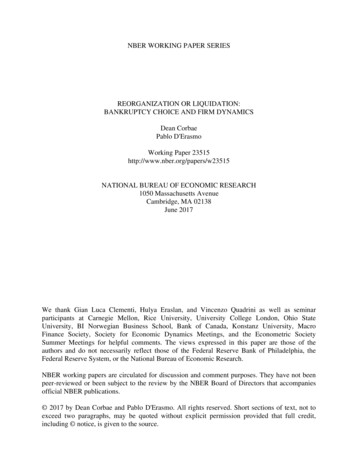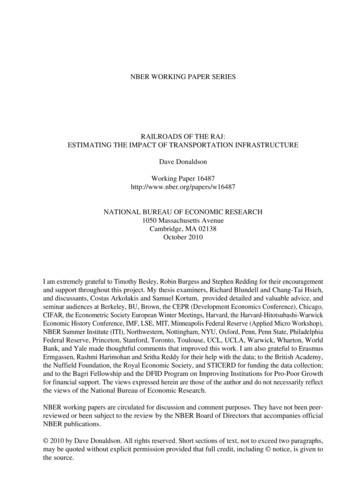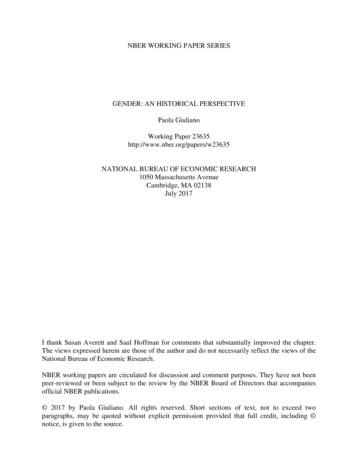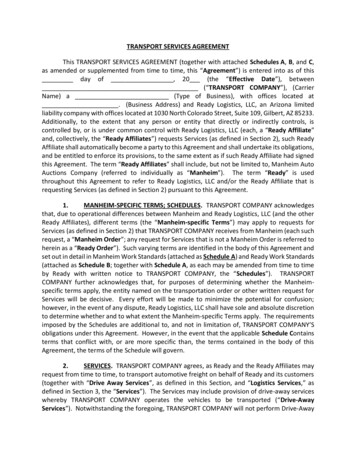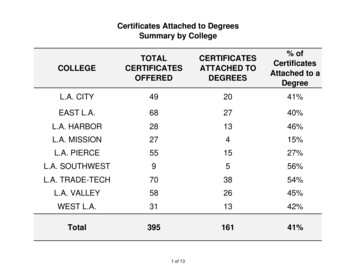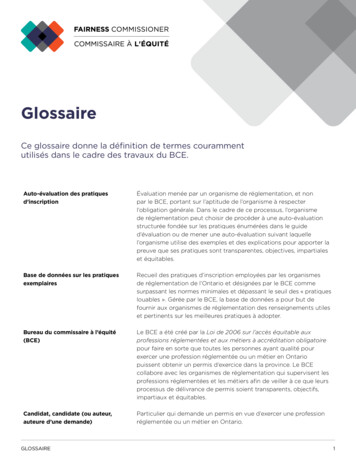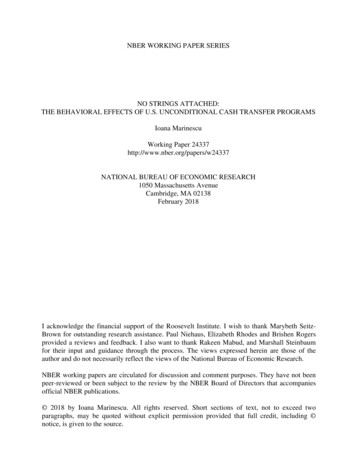
Transcription
NBER WORKING PAPER SERIESNO STRINGS ATTACHED:THE BEHAVIORAL EFFECTS OF U.S. UNCONDITIONAL CASH TRANSFER PROGRAMSIoana MarinescuWorking Paper 24337http://www.nber.org/papers/w24337NATIONAL BUREAU OF ECONOMIC RESEARCH1050 Massachusetts AvenueCambridge, MA 02138February 2018I acknowledge the financial support of the Roosevelt Institute. I wish to thank Marybeth SeitzBrown for outstanding research assistance. Paul Niehaus, Elizabeth Rhodes and Brishen Rogersprovided a reviews and feedback. I also want to thank Rakeen Mabud, and Marshall Steinbaumfor their input and guidance through the process. The views expressed herein are those of theauthor and do not necessarily reflect the views of the National Bureau of Economic Research.NBER working papers are circulated for discussion and comment purposes. They have not beenpeer-reviewed or been subject to the review by the NBER Board of Directors that accompaniesofficial NBER publications. 2018 by Ioana Marinescu. All rights reserved. Short sections of text, not to exceed twoparagraphs, may be quoted without explicit permission provided that full credit, including notice, is given to the source.
No Strings Attached: The Behavioral Effects of U.S. Unconditional Cash Transfer ProgramsIoana MarinescuNBER Working Paper No. 24337February 2018JEL No. H24,I18,I28,I38,J21,J22ABSTRACTThe universal basic income has become a widely discussed measure in policy circles around theworld. In this review, we cover the evidence relevant to its potential impact in the US, and indeveloped countries more generally. Many studies find no statistically significant effect of anunconditional cash transfer on the probability of working. In the studies that do find an effect onlabor supply, the effect is small: a 10% income increase induced by an unconditional cashtransfer decreases labor supply by about 1%. The evidence shows that an unconditional cashtransfer can improve health and educational outcomes, and decrease criminality and drug &alcohol use, especially among the most disadvantaged youths.Ioana MarinescuUniversity of PennsylvaniaSchool of Social Policy & Practice3701 Locust WalkPhiladelphia PA, 19104-6214and NBERioma@upenn.edu
Executive SummaryProviding cash directly to individuals has often been met with criticism, suspicion, and fear: the thinkinggoes that people who need financial assistance are not to be trusted, as their financial position reflects amoral failing rather than a societal one. Are these objections to cash transfer programs rooted in myth orempirical evidence? As the debate about a universal basic income gains prominence, it is important to setthe record straight about the behavioral effects of unconditional cash assistance.In this evidence review, we explore how unconditional cash transfers affected the behavior of recipientsin three major natural experiments. While the amounts dispersed and time periods were distinct in eachexperiment, each provided money without set conditions and without a means test. We synthesize data forthe following outcomes: consumption; labor force participation (employment, hours worked, andearnings); education; health; and other social outcomes, such as marriage or fertility choices. Each ofthese programs shares different components of a universal basic income (UBI), a cash transfer thateveryone within a geographic/political territory receives on a regular basis with no conditions on a longterm basis. By understanding the effects of these programs, we can generate answers to how anunconditional cash transfer program might affect recipients in the future.We review the empirical results from the U.S. and Canadian negative income tax experiments, the AlaskaPermanent Fund Dividend, and the Eastern Band of Cherokees casino dividend program, as well as a fewother assorted studies. While all of these programs provide unconditional cash transfers, only thenegative income tax experiments guaranteed enough money to live on. The negative income taxexperiments ensured recipients would receive up to 25,900 in today’s dollars, but the program alsoimposed high tax rates on earned income and reduced the benefit the more recipients earned. The Alaskafund provides an average of one to two thousand dollars annually to all Alaskan residents and thedividend is taxed at the regular income tax rate. The casino dividends provide an average of four thousanddollars and is also unaffected by earned income. An overview of the empirical results follows.Labor participation: Did participants stop working, work less, and/or earn less? Overall, the programs analyzed suggest either no effect on labor market supply or a slightreduction in work and earnings. The evidence does not suggest an average worker will drop outof the labor force when provided with unconditional cash, even when the transfer is large.The effect on employment in the negative income tax experiments was generally not statisticallysignificant, except for the largest experiment site, which saw a 4 percentage point decline in theemployment rate. On average, the reduction in hours worked for all experiments was between twoweeks (for husbands) and four weeks (for youth) of full-time employment over a year. Peoplewho participated in the largest experiment experienced a 4.6 percent reduction in employmentand 7.4 percent reduction in earnings ( 1,800 annually) for treated individuals over many yearsafter the experiment ended, perhaps due to earlier retirement.The casino dividend had no impact on the labor supply of participants.The Alaska dividend has no impact on the employment-to-population ratio in Alaska compared tocontrol states. The program increases the share of Alaskans who work in part-time jobs by twopercentage points.Because neither the casino nor Alaska dividend programs provide sufficient income to replaceearned income, we augment the negative income tax research on labor outcomes with an analysisof lottery winners. According to this body of work, the overwhelming majority of recipients of2
windfall cash disbursed annually do not drop out of the labor force. While many lottery winnersreduce the number of hours worked, the majority remain in the labor force. The research finds a 100 increase in income leads to an 11 decrease in earnings based onlottery winners and negative income tax experiment participants, or no decrease at all in the caseof the casino payments.Consumption: Did participants purchase more goods and services, and if so, which? The negative income tax experiments in two rural states showed positive impacts on the qualityof nutrition, suggesting an increase in spending on food. Otherwise, data on consumption was notcollected. Receiving an Alaska dividend affected the timing of consumption, as recipients consumedsignificantly more on non-durables and services the month they received a dividend.Education: Did participants attain more schooling? School attendance, grades, and test scores for the children of negative income tax recipients weretypically higher than the control population, especially for younger and poorer children. TheCanadian program lowered dropout rates for 11th graders. An additional 4,000 per year for the poorest households in the casino dividend programincreased educational attainment by one year.Health: Did participants have improved health outcomes? The Canadian negative income tax was the only experiment to track health outcomes, and itfound that recipients experienced an 8.5 percent decrease in hospitalizations compared to thecontrol group, especially for mental health, accidents, and injuries.Casino dividend payments improved mental health among Native American recipients relative tonon-Native participants in a longitudinal study. Once they reached adulthood, children whoreceived casino dividends were significantly less likely to experience alcohol or cannabis use ordependence.There is little to no impact on health outcomes for Swedish lottery winners, likely because of theuniversal healthcare system in the country.Other: For the Gary, IN experiment, fertility decreased and birth weights increased. The original analysisof the IMEs showed an increase in divorce, but these findings were later strongly disputed.Self-reported criminalized activity decreased among recipients of the EBC casino dividend,particularly for minor crimes and drug-dealing activities. Children also reported more positiveinteractions with parents. Casino payments did not change household composition or maritalstatus.In sum, the effects of unconditional cash transfers vary depending on program design, but there is eitherno impact on or a moderate decrease in labor participation and a significant increase in other quality-oflife benefits (mental and physical health, education outcomes, parenting, reduced criminal activity, etc.).3
IntroductionWhat happens when people receive cash with no strings attached?This question and many others are at the core of a debate that has gained remarkable interest and tractionin the United States in the last year. The idea is bold, yet not new: a universal basic income (UBI) hasfloated in and out of political discourse for decades (Thigpen 2016). A UBI, also referred to as aguaranteed minimum income or income guarantee, is a cash transfer that everyone within ageographic/political territory receives on a regular basis with no conditions on a long-term basis. 2 Such aguaranteed minimum income can also be implemented through a negative income tax (NIT) scheme,which ensures a minimum income through tax credits.With its resurgence in the debate about economic security, many questions arise for those who considerthe merits of guaranteed income: How does receiving cash directly (rather than conditional welfare,unemployment insurance, or food stamp benefits) affect recipients’ behavior and economic security? Willpeople who receive unconditional cash grants drop out of the workforce and do nothing? Will they wastetheir supplements on cigarettes and alcohol? In other words, would such a program be a waste of publicinvestment? We can generate possible answers to these questions by looking to historical precedents,reviewing the behavioral and microeconomic effects of past and ongoing programs that deliver cashgrants to individuals without conditions. By gaining a deeper understanding of the behavioral results ofthese real-world cash transfer experiments and programs, we can inform the ongoing debate about UBI.The current discourse around UBI explores various program designs, from tax-and-transfer models tomodels that establish co-ownership of collective resources through dividend programs (see Thigpen 2016for more detail on the intellectual history of these models). In general, what each of the proposedvariations on UBI has in common are the following signature features: The program distributes cash directly to the recipient without a means test (i.e. it is not necessaryto show that your income is below a certain threshold in order to qualify for the program) or setconditions for receiving the money.The funds are distributed over the long term.Everyone within a set geographic region receives the supplement.To date, there has been no single government-funded cash transfer program in the United States thatchecks each of those boxes. However, taken holistically, there are several historical experiments andpilots we can review to understand the effects of a potential cash transfer program that unites all their keyfeatures. This paper will explore the labor supply, health, and education effects of those experiments andoffer insight into what those results can teach us about creating unconditional cash transfer programs indeveloped countries, with a primary focus on the United States.The historical precedent that most closely mirrors a full unconditional cash transfer or UBI program is thenegative income tax experiments of the 1970s, which took place in six American states and one province2There is debate about whether absolutely all residents are entitled to the transfer. For example, would non-citizensor incarcerated individuals be eligible? The discussion of such eligibility criteria is beyond the scope of this review.4
in Canada. Since the design of those experiments does not allow us to distinguish between income andsubstitution effects (as we explain in the text box below), we will also explore the effects of two longrunning unconditional cash transfer programs: the Eastern Cherokee Nation’s casino revenue dividendand the Alaska Permanent Fund Dividend. Though there are some external validity and comparabilitylimitations, we will also touch on the effects of receiving lottery winnings on an annual basis in thedeveloped world to understand the pure income effect of large unconditional cash transfers. We end witha synthesis of the effects of unconditional cash transfers in the developing world, where there is morerobust experimental work on this topic. It is important to note that each of these experiments deals withvery different sample populations; residents of Alaska, members of the Eastern Band of Cherokees nation,and people who play the lottery are not representative of the entire population and thus our extrapolationto broader populations must consider these limitations.Overall, our goal is to answer the following questions: What do people do when they receive cash with nostrings attached? How does receiving an unconditional cash transfer affect a recipient’s work habits,health, education, and family?Testing “Income Maintenance”: The Negative Income Tax Experiments of the1970sHistorical contextIn the late 1960s and early 1970s, policy experts took the long debate over the best way to structuregovernment welfare programs from conversation to experiment. Many believed that a negative incometax program or refundable tax credit would be a simpler and more effective way to provide a safety net tothe poor than programs like Aid to Families with Dependent Children (AFDC, also known as welfare)and the Food Stamps Program (now called the Supplemental Nutrition Assistance Program). In theseexisting programs, benefits are foregone entirely when income rises above a certain threshold, whichcritics say contributes to a poverty trap. The NIT model provides a guaranteed income floor toparticipants, but it is structured differently than a simple universal basic income scheme that cuts equalchecks to all citizens. Under an NIT scheme, the government guarantees a maximum cash transfer benefitof G, which serves as the basic income guarantee. The government reduces the amount of the cashtransfer by a tax or benefit-reduction rate (t) for each dollar of earned income (Hum & Simpson 1993).These earnings are often therefore implicitly taxed at a high rate: Since cash grants gradually diminish themore an individual works, it can be argued that the model disincentivizes work by low-income individualsmore than a prototypical UBI model with no obvious labor supply substitution effect. On the other hand,the NIT model ostensibly penalizes work less than either AFDC or SNAP.Negative income tax advocates thus hoped their model would avoid the “welfare trap” and streamlineexisting social safety net programs. The U.S. Office of Economic Opportunity under President Johnsonheralded the idea and set forth a plan for replacing traditional welfare with an NIT. A White House taskforce and presidential commission debated the plan beyond Johnson’s time in office, and under PresidentNixon, Donald Rumsfeld steered the project away from full implementation and toward experimentation,thus giving rise to the experimental results reviewed here (Forget 2011).5
The U.S.’s NIT experiments had several goals. First, experimenters sought to compare “internally validdirect estimates of the relative costs of AFDC and the negative income tax” (Munnell 1986) to determinewhich program was more likely to disincentivize work. Would the high marginal tax rates imposed onearned income while receiving AFDC benefits be a stronger disincentive, or would the lack of a workrequirement under the NIT scheme enable recipients to choose not to work with no penalty? Policyexperts at the time knew that the specific design of an NIT model would disincentivize work to somedegree; thus, their goal was not to determine whether labor supply would be affected by the program butby how much it would be affected (Burtless 1986). As experimenters gathered data over time, additionalgoals and questions arose: How would health, family formation and fertility, and human capital beaffected (Forget 2011)?The NIT experiments authorized by the federal government, which were the first randomized controltrials in the social sciences, took place from 1968 to 1982. The first experiment took place in urban areasin New Jersey and Pennsylvania (1968–1972, n 1,216), with subsequent experiments in rural areas ofIowa and North Carolina (1970–1972, n 809), Gary, Indiana (1971–1974, n 1,799), and Seattle,Washington (1970–1978, n 4,800), which was extended in 1972 to Denver, Colorado (GiveDirectly2016). The Seattle/Denver Income Maintenance Experiment, referred to as SIME/DIME, was the largestand longest-running of the four. In SIME/DIME, about half of the 4,800 participants were guaranteed anincome of 25,900 in 2013 dollars (Price and Song 2016), which was the most generous of theexperiments. All experiments varied different combinations of tax rates and guarantee levels (e.g. aguarantee of 75 percent of the federal poverty line with a 50 percent tax rate on earned income) to studyeffects on work (Burtless 1986). A detailed breakdown of the features of each income maintenanceexperiment is listed in Hum and Simpson (1993).Simultaneously, from 1974 to 1979, Canada launched a similar experiment in the province of Manitobacalled Mincome. While the two sets of programs share many common features, the United States NITprogram differed in some ways from Canada’s Mincome experiment. First, the Mincome programincluded a saturation site—the small rural town of Dauphin—in which all 10,000 residents were eligibleto participate, in addition to a randomized sample in Winnipeg that mirrored the U.S. experimentaldesign. Second, the experiment was originally conceived as a first step in an eventual universal basicincome (to complement Canada’s universal healthcare system), rather than a replacement or reform ofexisting welfare programs. Third, the Mincome experiment offered 60 percent of the poverty line (or lowincome cut-off) for Canada across the board, rather than varying the guarantee and tax rate levels within asample. The project and payments ran for four years, but due to insufficient funding, data collectionceased after two. The data that had been collected was archived and largely unanalyzed for decades, untilEvelyn Forget analyzed the untouched data in 2011. Forget and her colleagues collected the data fromtapes, archived boxes, and a population health database to determine the influence of income supplementson health outcomes.Effects on consumptionThere is no systematic evidence on the effects on consumption across the NIT experiments becauseconsumption was not measured in the standard data that was collected. However, the rural NIT in Iowaand North Carolina showed positive impacts on the quality of nutrition (Salkind and Haskins 1982),suggesting an increase in spending on food.6
Effects on employment, hours, and earningsThe NIT experiments were a complex intervention, and the net impact on labor supply is hard to predictex ante because it depends on whether the NIT is more or less generous than the existing welfare and taxsystem. Two countervailing forces are at play: On the one hand, many of the NIT treatments provided ahigher level of income guarantee than other safety net programs, and this was especially true for theSIME/DIME experiment. This higher income guarantee should induce a decrease in labor supply due tothe income effect; when people have a higher unearned income, they choose to work less.On the other hand, the tax rate on the income guarantee was often smaller than the implicit tax rate onbenefits in the existing system, which should stimulate work through an incentive effect known as thesubstitution effect. To clarify, the implicit tax rate on a benefit is the number of cents that are taken awayfrom that benefit when a recipient earns an additional dollar of labor income. A 100 percent tax ratewould mean that each dollar earned resulted in one dollar of benefit taken away: existing benefits oftenhad implicit taxes close to 100%. In the NIT experiments, the tax rate was not 100 percent but rangedbetween 30 and 80 percent; i.e., between 30 and 80 cents of benefits were taken away for each dollarearned.We will now discuss the overall impact of the NIT experiments on labor supply, before turning toestimates of the income and substitution effects that come out of these experiments.The NIT experiments had a negative impact on employment among treated families (those who receivedthe benefit), but this effect was generally not statistically significant (Robins 1985); only the SIME/DIMEexperiment showed a statistically significant effect, with a 4 percentage point decline in the employmentrate. The SIME/DIME experiment was the most generous, and had the largest sample size (Burtless1986), so it makes sense for the impacts to be larger and more significant. However, because NITrecipients underreported earnings in order to get a larger benefit payment, the impacts of NIT onemployment are likely exaggerated (Robins 1985; Burtless 1986; Ashenfelter and Plant 1990). Anotherissue that likely contributed to an overestimation of labor supply effects is selective attrition: Ashenfelterand Plant (1990) show that treated families who received no payment (because they had higher outsideearnings) and therefore likely had no labor supply response to the NIT were more likely to leave theexperiment, affecting the sample.Altogether, the NIT experiments show a negative impact on hours worked, though the effect is not alwaysstatistically significant (Burtless 1986; Robins 1985). On average, the reduction in labor supply wasbetween two and four weeks of full-time employment over a year (Robins 1985). Furthermore, the impacton working at all (what economists call “the extensive margin” of labor supply) was generally larger thanthe impact on hours worked for those who were working (what economists call “the intensive margin” oflabor supply) (Burtless 1986). Again, misreporting of earnings implies that the hours effect wasexaggerated: In the case of the Gary experiment, the entire negative effect of NIT on hours worked can beexplained by misreporting (Burtless 1986).Using variation in tax rates and income guarantees across experiments, one can identify the substitutioneffect and the income effect. There is not enough data to reliably estimate the impact for each of thedifferent guaranteed income and tax rates that were tried in the experiment, i.e. it is not possible toestimate the income and substitution effects non-parametrically (Ashenfelter and Plant 1990). If we are7
willing to make some additional assumptions, such as assuming that the income and substitution effectsare proportional to the tax rate and income guarantee levels, we can identify the income and substitutioneffects in parametric models. Using parametric models and synthesizing prior results, Robins (1985) findsthat the income elasticity typically varies between -0.06 and -0.10 depending on the demographic group.This implies that for a 1-dollar increase in cash payments, and holding effective marginal tax rates andhourly wage fixed, participants’ earnings decrease by between 6 and 10 cents. As for the substitutioneffect, it is estimated to be generally between 0.08 and 0.17, meaning that lower effective tax ratesinducing a 10 percent increase in the net-of-tax hourly wage led to a 0.8 to 1.7 percent increase in totalearnings (Robins 1985). Hum and Simpson (1993) also calculated income and substitution effects for theCanadian negative income tax experiment Mincome: Both are insignificant, and the estimated incomeeffect is zero. Taking together all NIT experiments, income and substitution effects are both quite small,and smaller than the non-experimental estimates (Hum and Simpson 1993). It is also important toremember that these elasticities are based on extrapolations from the labor supply effects of the NITs,which, as pointed out above, have been overestimated. It is therefore likely that these elasticities are upperbounds for the impact of a NIT on labor supply.There is important variation in the labor supply effects of a NIT by individual characteristics. In terms ofabsolute hours and employment responses, husbands and whites tend to be less responsive; in terms ofelasticities, the income effect is largest for single mothers, then for husbands and then for wives (-0.06).The substitution effect is largest for wives (0.17), then for single mothers, and then for husbands (Robins1985). Income effects for husbands and wives are quite similar. Income and substitution effects tend to besmaller than the non-experimental estimates, especially for women (Hum and Simpson 1993). Overall,these results suggest that wives are more sensitive to the substitution effect, i.e., implicit taxes on theirearnings, than to the income effect. The opposite is true for husbands. There are many possible reasonsthat could explain this differential, and given the limited amount of empirical evidence, we will notspeculate as to the reasons behind these differences. It is worth noting that the labor market in the 1970sdid have more gender segregation and lower workforce participation for women, so it is unclear whetherthe same gender differences would be observed under a similar policy today.An unpublished study (Price and Song 2016) has used Social Security data to investigate the long-runimpact of the SIME/DIME experiment on labor supply. The authors match experimental participants withtwo or more children to Social Security records, using the birth dates of the children to identifyparticipants; in this way they are able to match about half of the participants. Their analysis is thereforebased on comparing matched participants with two or more children to control individuals with two ormore children. They find a 4.6 percent reduction in employment (3.3 percentage points) and 7.4 percentreduction in earnings ( 1,800 annually) for treated individuals over many years after the experimentended. The authors further investigate the timing of the effects. Immediately after the experiment wasconcluded and individuals were no longer receiving transfers from this source, the impact of NIT on laborsupply was non-existent. However, as people reached 50–60 years old, there were substantial labor supplyreductions among the treated participants. The reason why the impact took so long to materialize isunclear, but the authors suggest it is related to relatively earlier retirement. 3 The study also investigates3Price and Song offer a few possible explanations for the long-term effects on adults: The additional wealth shockprovided by the experiment could have increased total assets in treated families, making it possible to retire earlier;participants may have developed relatively less human capital if they worked less during the time of the experiment;or they may have changed their preferences for more leisure and opted to retire sooner.8
the impact of the NIT treatment on children’s long-run labor market outcomes and finds no effect onworking or earnings.Effects on education, health and other social outcomesEffects on children’s educational outcomesResults show that school attendance, grades, and test scores for the children of participants who receivedthe NIT were typically higher (Maynard and Murnane 1979; Salkind and Haskins 1982). The impact ontest scores was larger for younger children and for children from poorer families (Maynard and Murnane1979). In Canada, the entire small rural town of Dauphin received Mincome. Forget (2011) matchesresidents from Dauphin to similar population centers in Manitoba as controls, and shows that the NITlowered high school dropout rates in 11th grade. While matching is not as reliable a method asrandomization and significance tests for this outcome were not reported, the results for Canada areconsistent with the results from the American NIT experiments. Overall, the NIT improved children’seducational outcomes. With higher income for families, children’s educational outcomes could haveimproved due to better material inputs (e.g., food and books) or indirect effects of parenting (e.g., morequality time with children).A precedent to the NIT is the Mothers’ Pension program that operated from 1911 to 1935. The programwas administered by each U.S. state, so it built in quasi-experimental variation. It allowed poor motherswithout a male breadwinner to receive a cash transfer, typically for three years, often on the condition ofnot working. The income test was enforced at enrollment in the program but was loosely enforcedthereafter, making the Mothers’ Pension somewhat comparable to an unconditional cash transfer. TheMothers’ Pension, which increased mothers’ incomes by about 30 percent, increased completed schoolingfor their sons by about a third of a year (Aizer et al. 2016).Effects on healthWhile no systematic data on health was collected in the NIT experiments, administrative health recordscould be used for Dauphin. The Canadian Mincome improved health, as measured by an 8.5 percentdecrease in hospitalizations compared to matched control towns (Forget 2011). The decrease inhospitalization was particularly large for mental health, accidents, and injuries. The NIT and Mincomeexperiments did not track use of controlled substances, but we will review that outcome variable in latersection
In sum, the effects of unconditional cash transfers vary depending on program design, but there is either no impact on or a moderate decrease in labor participation and a significant increase in other quality-of-life benefits (mental and physical health, education outcomes,

